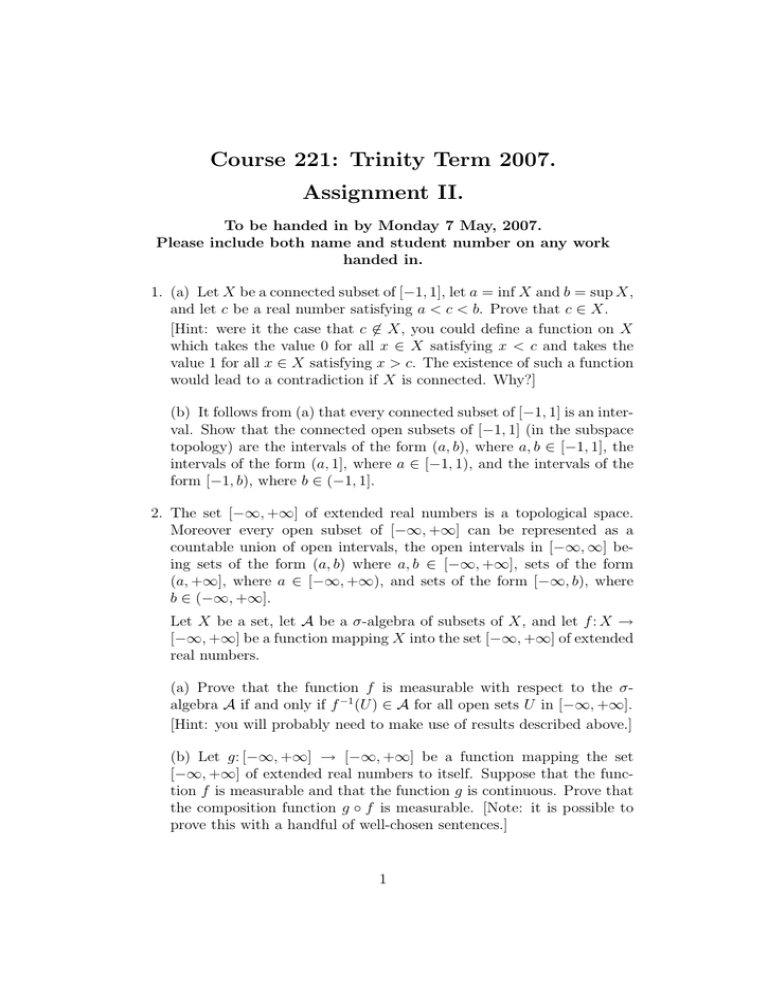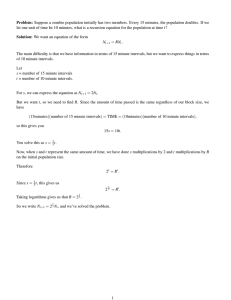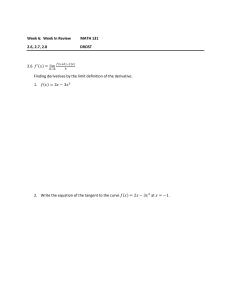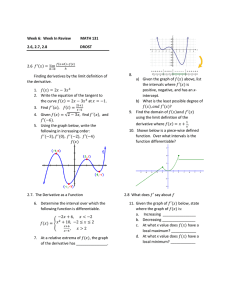Course 221: Trinity Term 2007. Assignment II.
advertisement

Course 221: Trinity Term 2007. Assignment II. To be handed in by Monday 7 May, 2007. Please include both name and student number on any work handed in. 1. (a) Let X be a connected subset of [−1, 1], let a = inf X and b = sup X, and let c be a real number satisfying a < c < b. Prove that c ∈ X. [Hint: were it the case that c 6∈ X, you could define a function on X which takes the value 0 for all x ∈ X satisfying x < c and takes the value 1 for all x ∈ X satisfying x > c. The existence of such a function would lead to a contradiction if X is connected. Why?] (b) It follows from (a) that every connected subset of [−1, 1] is an interval. Show that the connected open subsets of [−1, 1] (in the subspace topology) are the intervals of the form (a, b), where a, b ∈ [−1, 1], the intervals of the form (a, 1], where a ∈ [−1, 1), and the intervals of the form [−1, b), where b ∈ (−1, 1]. 2. The set [−∞, +∞] of extended real numbers is a topological space. Moreover every open subset of [−∞, +∞] can be represented as a countable union of open intervals, the open intervals in [−∞, ∞] being sets of the form (a, b) where a, b ∈ [−∞, +∞], sets of the form (a, +∞], where a ∈ [−∞, +∞), and sets of the form [−∞, b), where b ∈ (−∞, +∞]. Let X be a set, let A be a σ-algebra of subsets of X, and let f : X → [−∞, +∞] be a function mapping X into the set [−∞, +∞] of extended real numbers. (a) Prove that the function f is measurable with respect to the σalgebra A if and only if f −1 (U ) ∈ A for all open sets U in [−∞, +∞]. [Hint: you will probably need to make use of results described above.] (b) Let g: [−∞, +∞] → [−∞, +∞] be a function mapping the set [−∞, +∞] of extended real numbers to itself. Suppose that the function f is measurable and that the function g is continuous. Prove that the composition function g ◦ f is measurable. [Note: it is possible to prove this with a handful of well-chosen sentences.] 1 Note [This is not part of the assignment.] The open sets in [−∞, +∞] correspond to those in [−1, 1] under the homeomorphism ϕ: [−∞, +∞] → [−1, 1] from [−∞, ∞] to [−1, 1] defined such that ϕ(+∞) = 1, ϕ(−∞) = −1 and ϕ(x) = x(1 + |x|)−1 for all x ∈ R. In particular the open intervals in [−∞, +∞] correspond, under ϕ, to the intervals in [−1, 1] that are open with respect to the subspace topology on [−1, 1]. This enables us to characterize the collection of open intervals in [−∞, +∞] as described in question 2. Let X be a subset of [−1, 1] which is open with respect to the subspace topology on [−1, 1], let X0 be a connected component of X, and let s ∈ X. If s ∈ (−1, 1) then there exists δ > 0 such that (s − δ, s + δ) ⊂ X. But the interval (s − δ, s + δ) is a connected set containing s. It follows from the definition of connected components that (s − δ, s + δ) ⊂ X0 . Similarly if s = 1 then there exists δ > 0 such that (1 − δ, 1] ⊂ X0 , and if s = −1 then there exists δ > 0 such that [−1, −1 + δ) ⊂ X0 . This shows that every connected component of X is open with respect to the subspace topology on [−1, 1]. Such a connected component is therefore an interval of the sort described in 1(b). It follows from this that every component of X contains rational numbers. Any topological space is the disjoint union of its connected components. Thus, in particular, every subset X of [−1, 1] that is open with respect to the subspace topology on [−1, 1] is a disjoint union of its connected components, and these connected components are intervals of the sort described in 1(b). Moreover the number of such connected components is countable. Indeed let S be the set of connected components of S, let B be the set of rational numbers belonging to X, and let f : B → S be the function that sends each rational number in B to the connected component to which it belongs. Then B is a countable set, f : B → S is a surjection, and therefore S is a countable set. We deduce from this that every connected subset [−1, 1] that is open with respect to the subspace topology can be represented as a countable union of intervals of the sort described in question 1(b). It follows from this that every subset of [−∞, ∞] can be represented as a countable union of intervals of the sort described in question 2. 2






